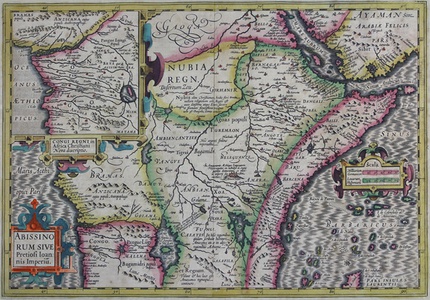| Method | Copper engraved with early hand colour |
| Artist | Mercator, Gerard and Hondius, Jodocus |
| Published | [Amsterdam, c.1620] |
| Dimensions | 345 x 488 mm |
| Notes |
A highly decorative early seventeenth century map of Central and Eastern Africa, from a French edition of the Mercator-Hondius Atlas Major. The map stretches from Nubia in the north to the 'Mountains of the Moon' in the south, and from the Congalese coast in the west to the southern part of the Arabian peninsula to the east. The various regions and kingdoms of the continent are outlined in beautiful early hand colour. The map's title, enclosed in a decorative cartouche in the bottom left corner, makes it clear that it was intended as a response to Ortelius' celebrated map of the Kingdom of Prester John, a fictitious Christian monarch purported to be the ruler of a lost, but great, Nestorian kingdom. Hondius, like Ortelius, equates Prester John with the early Coptic Christian communities in Egypt, the Sudan, and Ethiopia, making him Emperor of Abyssinia. In the top left, a large inset map shows another Christian community in the Congo, directly below Anzicana, a region described as populated by a race of man-eaters. A third strapwork cartouche in the bottom right contains a scale in German and Spanish miles. The lengthy French text on the verso describes the history and geography of the region. Prester John was a mythical Christian king popular in European chronicles and traditions from the 12th to the 17th century. John was supposedly descended from David, or in some traditions, the Three Magi, and regarded as an important defence against the barbarians, and a potential ally for the Crusades. He was said to rule over a Nestorian Christian nation lost amid the Muslims and pagans of the Orient. Originally believing him to be somewhere in the Middle East, Pope Alexander III sent John a letter in 1177 begging him to help against the Mongols, but his messenger never returned. As Polo and other travellers opened the East without finding him, Prester John's kingdom retreated into the unknown. Although Waldseemüller's maps of 1507 place him in India, Fries moved him to Africa in 1522. Eventually Portuguese explorers convinced themselves that they had found him in Ethiopia, where he resides on this map. Gerard Mercator (1512 - 1594) originally a student of philosophy was one of the most renowned cosmographers and geographers of the 16th century, as well as an accomplished scientific instrument maker. He is most famous for introducing Mercators Projection, a system which allowed navigators to plot the same constant compass bearing on a flat map. His first maps were published in 1537 (Palestine), and 1538 (a map of the world), although his main occupation at this time was globe-making. He later moved to Duisburg, in Germany, where he produced his outstanding wall maps of Europe and of Britain. In 1569 he published his masterpiece, the twenty-one-sheet map of the world, constructed on Mercator's projection. His Atlas, sive Cosmographicae Meditationes de Fabrica Mundi, was completed by his son Rumold and published in 1595. After Rumold's death in 1599, the plates for the atlas were published by Gerard Jr. Following his death in 1604, the printing stock was bought at auction by Jodocus Hondius, and re-issued well into the seventeenth century. Jodocus Hondius (14th October 1563 - 12th February 1612) was a Dutch Flemish cartographer, engraver, and publisher. Hondius is most famous for reviving the primacy of the work of Gerard Mercator, through the publication of his Atlas, and the smaller Atlas Minor, in the early seventeenth century, at a time when cartography was largely dominated by Ortelius' Theatrum Orbis Terrarum. The Mercator-Hondius Atlas was composed of maps pulled from plates Hondius had purchased from Mercator's grandson, as well as thirty-six new plates Hondius commissioned, and in many cases engraved, himself. He is also believed to have been the chief engraver of the plates for John Speed's Theatre of the Empire of Great Britaine. Following his death, he was succeeded by his sons, Jodocus the Younger and Henricus, as well as his son in law Jan Jansson. Condition: Central vertical fold, as issued. Time toning and foxing to margins. French text on verso. Old mounting tape to top edge of verso. |
| Framing | |
| Price | £500.00 |
| Stock ID | 50211 |

